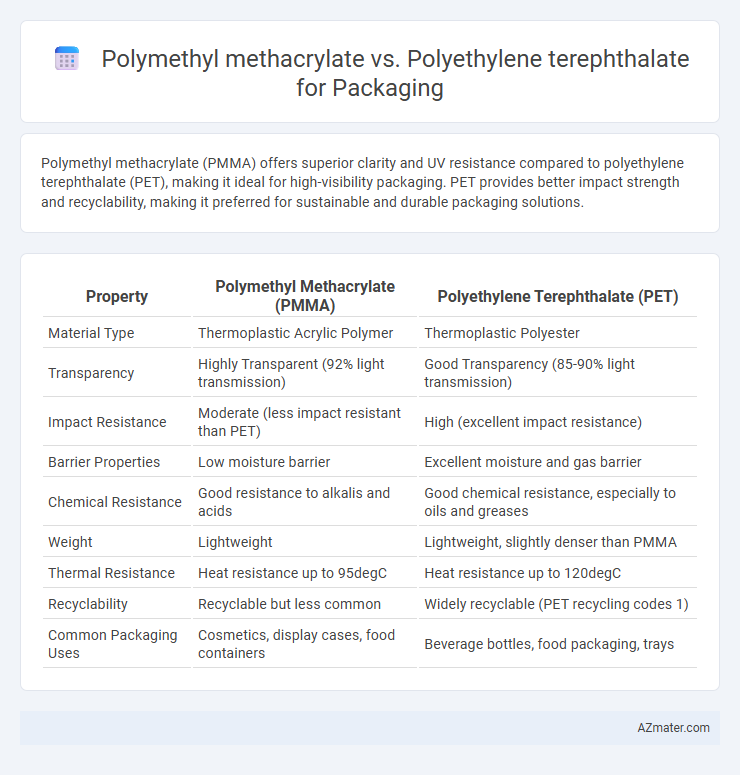Polymethyl methacrylate (PMMA) offers superior clarity and UV resistance compared to polyethylene terephthalate (PET), making it ideal for high-visibility packaging. PET provides better impact strength and recyclability, making it preferred for sustainable and durable packaging solutions.
Table of Comparison
| Property | Polymethyl Methacrylate (PMMA) | Polyethylene Terephthalate (PET) |
|---|---|---|
| Material Type | Thermoplastic Acrylic Polymer | Thermoplastic Polyester |
| Transparency | Highly Transparent (92% light transmission) | Good Transparency (85-90% light transmission) |
| Impact Resistance | Moderate (less impact resistant than PET) | High (excellent impact resistance) |
| Barrier Properties | Low moisture barrier | Excellent moisture and gas barrier |
| Chemical Resistance | Good resistance to alkalis and acids | Good chemical resistance, especially to oils and greases |
| Weight | Lightweight | Lightweight, slightly denser than PMMA |
| Thermal Resistance | Heat resistance up to 95degC | Heat resistance up to 120degC |
| Recyclability | Recyclable but less common | Widely recyclable (PET recycling codes 1) |
| Common Packaging Uses | Cosmetics, display cases, food containers | Beverage bottles, food packaging, trays |
Introduction to PMMA and PET in Packaging
Polymethyl methacrylate (PMMA) offers high clarity, UV resistance, and rigidity, making it ideal for premium packaging applications requiring excellent optical properties. Polyethylene terephthalate (PET) is widely used due to its strength, lightweight nature, and excellent barrier properties against moisture and gases, which extend product shelf life. Both polymers play crucial roles in packaging, with PMMA favored for display aesthetics and PET for functional protection and recyclability.
Chemical Structure and Properties Comparison
Polymethyl methacrylate (PMMA) features a rigid, glass-like polymer chain with ester groups that provide high clarity, UV resistance, and excellent weatherability, making it ideal for transparent packaging applications. Polyethylene terephthalate (PET) consists of repeating ester linkages in an aromatic backbone, offering superior strength, chemical resistance, and barrier properties against moisture and gases, which are critical for food and beverage packaging. The distinct chemical structures influence their thermal stability, mechanical properties, and recyclability, with PET generally preferred for its toughness and barrier performance, while PMMA excels in optical clarity and surface hardness.
Mechanical Strength and Durability
Polymethyl methacrylate (PMMA) exhibits high tensile strength and excellent rigidity, making it resistant to impact and deformation in packaging applications. Polyethylene terephthalate (PET) offers superior toughness and flexibility, providing enhanced durability against cracking and environmental stress. Both materials are widely used in packaging, with PMMA favored for clarity and stiffness, while PET is preferred for its balance of mechanical strength and long-term durability.
Optical Clarity and Appearance
Polymethyl methacrylate (PMMA) offers superior optical clarity compared to polyethylene terephthalate (PET), with a higher light transmittance of approximately 92% versus PET's 85-90%. PMMA maintains a crystal-clear, glass-like appearance, making it ideal for premium packaging that requires maximum transparency and aesthetic appeal. PET, while slightly less clear, provides greater toughness and chemical resistance, which balances optical performance with durability for everyday packaging applications.
Barrier Properties: Moisture and Gas Permeability
Polymethyl methacrylate (PMMA) offers moderate moisture barrier properties but generally exhibits higher gas permeability compared to Polyethylene terephthalate (PET), making PET more suitable for packaging applications requiring superior protection against oxygen and carbon dioxide ingress. PET demonstrates excellent moisture resistance and significantly lower oxygen transmission rates (OTR), enhancing shelf life for perishable goods. The superior barrier performance of PET contributes to its widespread use in food and beverage packaging where moisture and gas impermeability are critical.
Thermal Resistance and Temperature Tolerance
Polymethyl methacrylate (PMMA) exhibits a thermal resistance up to approximately 95degC, making it suitable for moderate heat applications but prone to deformation at higher temperatures. Polyethylene terephthalate (PET) offers superior temperature tolerance, maintaining structural integrity up to around 120degC, which enables better performance in hot-fill packaging processes. The higher glass transition temperature of PET enhances its suitability for applications requiring greater thermal stability and durability compared to PMMA.
Environmental Impact and Recyclability
Polymethyl methacrylate (PMMA) offers excellent clarity and UV resistance but poses challenges in recycling due to limited infrastructure and energy-intensive processing, resulting in lower environmental sustainability compared to polyethylene terephthalate (PET). PET is widely recycled globally with established collection and recycling systems, reducing landfill waste and greenhouse gas emissions significantly in packaging applications. Both materials contribute to plastic pollution; however, PET's higher recyclability and lower carbon footprint make it a more environmentally favorable choice for sustainable packaging solutions.
Cost-effectiveness and Market Availability
Polymethyl methacrylate (PMMA) generally offers higher clarity and UV resistance but comes at a higher cost compared to polyethylene terephthalate (PET), making PET more cost-effective for large-scale packaging applications. PET dominates market availability due to its widespread use in beverage bottles, food containers, and its superior recyclability, contributing to lower lifecycle costs. The extensive global production infrastructure for PET ensures greater accessibility and price competitiveness, favoring its selection for cost-sensitive packaging solutions.
Applications: Best Uses for PMMA vs PET
Polymethyl methacrylate (PMMA) excels in applications requiring high optical clarity and UV resistance, making it ideal for premium display packaging, cosmetic containers, and point-of-sale exhibits. Polyethylene terephthalate (PET) is preferred for food and beverage packaging due to its excellent barrier properties, strength, and recyclability, especially for bottles, jars, and flexible packaging films. For antimicrobial and moisture-sensitive products, PET's superior barrier performance outperforms PMMA, which is more suited for aesthetic-focused packaging solutions.
Choosing the Right Material for Packaging Solutions
Polymethyl methacrylate (PMMA) offers superior clarity, UV resistance, and scratch resistance, making it ideal for high-end packaging that requires excellent visual appeal and durability. Polyethylene terephthalate (PET) excels in impact resistance, chemical stability, and recyclability, positioning it as a cost-effective and sustainable option for food and beverage containers. Selecting the right packaging material depends on factors like product protection requirements, environmental impact considerations, and target market aesthetics.

Infographic: Polymethyl methacrylate vs Polyethylene terephthalate for Packaging
 azmater.com
azmater.com